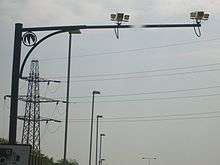SPECS (speed camera)

SPECS is an average speed measuring speed camera system[1] originally manufactured by Speed Check Services Limited, from which it takes its name. It is one of the systems used for speed limit enforcement in the United Kingdom. Speed Check Services was acquired by Vysionics in 2010.[2] This data is out of date Sean SPECS cameras were introduced in 1999.[3]
About SPECS cameras
SPECS cameras operate as sets of two or more cameras installed along a fixed route that can be from 200 metres (660 feet) to 10 kilometres (6.2 mi) in length.[4] They work by using an automatic number plate recognition (ANPR) system to record a vehicle's front number plate at each fixed camera site. As the distance is known between these sites, the average speed can be calculated by dividing this by the time taken to travel between two points.[5] The cameras use infrared photography, allowing them to operate both day and night.
There is a popular misconception that the Home Office has approved the SPECS system for single-lane use only. According to this theory, a motorist can therefore switch lanes between cameras and claim non-approval to avoid prosecution for speeding.[6] Indeed, the cameras can only operate in pairs, where each pair only monitors one lane of a multi lane road.[7] So in theory, one can escape detection by changing lanes between the entry and exit cameras.[7] In reality, two or more sets of pairs of cameras are arranged to have overlapping areas of monitoring;[7] since the driver cannot tell which cameras are 'entry' and which are 'exit', as they look identical, they cannot tell where to change lane to escape detection.
The system has another deficiency in that since the cameras only read the front number plate of a vehicle, speeding motorcycles escape detection because they have no front number plate to read.
The cameras are often painted yellow and have been given the nickname "yellow vultures".[8]
Incidents
In February 2007 a letter bomb exploded at the accountants of Speed Check Services Limited in what was believed to be an attack on organisations related to DNA testing and road transport.[9]
Similar systems in other countries
Similar systems are being used in other countries:
See also
References
- ↑ "SPECS ¦ Average Speed Check Cameras & SpeedEnforcement". Vysionics. Retrieved 18 March 2013.
SPECS is a speed enforcement system, which uses linked Automatic Number Plate Recognition (ANPR) cameras to monitor the average speed of traffic over a section of road, or network of roads. It has been used in the UK to control speeds on routes with a collision history and at major roadworks since achieving UK Home Office Type Approved (HOTA) in 1999.
- ↑ "Supplying ANPR Cameras, Speed & Traffic Solutions". Vysionics. Retrieved 18 March 2013.
In 2010, Vysionics was created following the acquisitions of CRS and Speed Check Services
- ↑ http://www.vysionics.com/product/specs
- ↑ "SPECS - At a glance" (PDF) (Press release). Speed Check Services Limited. 2005-03-15. Archived from the original (PDF) on October 14, 2006. Retrieved 2007-04-19. External link in
|publisher=(help) - ↑ "A Guide to Type-Approval Procedures for Automatic Distance/Time Speedmeters used for Road Traffic Law Enforcement in Great Britain". Home Office. 2006-04-20. Archived from the original on 2008-10-23. Retrieved 2008-07-23.
- ↑ Ray Massey (December 15, 2006). "Drivers can avoid speeding tickets...by changing lanes". Mail Online. Retrieved 2008-06-11.
- 1 2 3 http://news.bbc.co.uk/1/hi/magazine/7048645.stm BBC magazine article on SPECS
- ↑ David Leask (April 11, 2010). "'Yellow Vultures' to target speeders". The Scotsman. Retrieved 2010-04-14.
- ↑ "Two hurt in 'mail bomb' explosion". BBC News. February 6, 2007. Retrieved 2008-06-11.
External links
- Speed Check Services official website
- Safety Tutor Autostrade per l'Italia